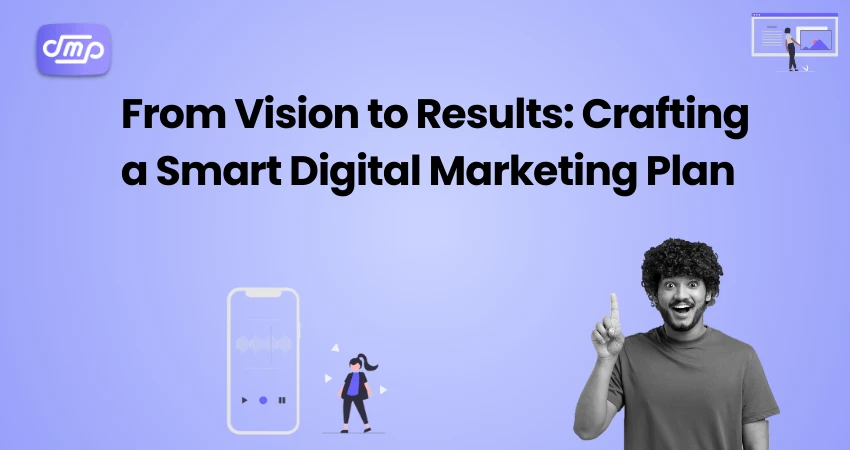
- September 1, 2025
- Digital Marketing, seo
- Digital Marketing
Table of Contents
Success in the rapidly evolving digital world of today stems from strategy rather than haphazard marketing initiatives. A clever digital marketing plan is a road map that links your company’s goal with quantifiable outcomes, not just a list of initiatives. Businesses can design a strategy that promotes growth, establishes credibility, and has a long-lasting effect by establishing specific objectives, knowing their target, and selecting the appropriate channels. The essential elements to creating a digital marketing plan that transforms abstract ideas into measurable results will be outlined in this article.
Defining the Vision
Clarity of purpose is the first step in every successful digital marketing plan. Marketing initiatives run the risk of becoming disorganized campaigns without a clear goal if they lack a compelling vision. Setting revenue goals is only one aspect of defining your vision; another is tying business goals to the value you wish to provide to your audience.
1. Comply with business objectives
Your organization’s overarching goals should be reflected in your digital marketing plan. Are you trying to:
- Boost brand recognition in untapped markets
- Produce quality leads for the sales force.
- Increase client loyalty and retention.
- Make your business a recognized authority in your field.
- Every action contributes to a quantifiable impact rather than vanity metrics when marketing is in line with company objectives.
2. Develop a Vision Focused on the Customer
Instead of looking within, a sensible vision looks outward. Consider customer outcomes rather than “we want to sell more products”:
- Assisting clients in resolving issues more quickly
- Using your solution to make their lives easier
- Giving information to help make better judgments
- This change fosters longer-lasting trust and closer ties.
3. Establish Early Definitions of Success
Before launching advertisements and channels, imagine what success looks like. Is it more engagement on LinkedIn, a specific quantity of monthly leads, or a percentage increase in website traffic? The entire plan remains accountable and focused when this benchmark is set early.
Understanding Your Audience

A clever digital marketing plan is based on what your audience needs, not what you want to communicate. It gets easier to craft messages that connect and convert when you have a greater understanding of who they are.
- Personas of Buyers with Depth: Get above superficial demographics. Identify your audience based on their decision-making obstacles, motivations, and challenges. This aids in creating marketing that are relevant and seem personal.
- Awareness of the Customer Journey: People don’t always buy anything after discovering it. They go through phases of consciousness, deliberation, and choice. By adapting your content to these phases, you can be sure that you’re reaching them with the appropriate message at the appropriate moment.
- Data-Based Insights: Whether it’s blog entries, videos, or LinkedIn updates, analytics tools show you what your audience is truly interested in. By applying these concepts, you may make sure that your plan is supported by facts rather than conjecture.
Setting SMART Marketing Goals
Without objectives, a digital marketing plan is like trying to navigate without a compass; you may get somewhere, but you won’t be able to tell if you’re on the right track. SMART goals provide clarity and structure, guaranteeing that every effort leads to quantifiable results.
The Meaning of SMART
- Specific: Clearly state your goals, likely as increasing the number of qualified leads.
- Measurable: Include a figure (e.g., 200 new leads) so that progress may be monitored.
- Achievable: Establish challenging yet doable objectives.
- Relevant: Make sure the target is closely related to more general corporate goals.
- Time-bound: Set a specific deadline, such as six months.
The Significance of SMART Goals
- The goal to help you maintain the unity and attention of your team.
- They offer standards by which success can be evaluated.
- They use data to support budgets and resource allocation.
Choosing the Right Digital Channels

The platforms that connect you to your audience and yield the highest return on investment are the focus of a well-thought-out digital marketing plan. Focus on the channels that best suit your objectives and consumer behavior rather than distributing your resources too widely.
- Media Owned: These channels—your blog, email list, and website—are within your control. They serve as the cornerstone of your online presence, allowing you to develop enduring relationships, nurture leads, and generate evergreen content.
- Media Earned: This includes the exposure you “earn” via social media sharing, PR mentions, SEO, and client recommendations. Without spending money on direct advertising, strong earned media increases organic reach and conveys credibility.
- Media Payments: Speed and scalability are provided by paid channels such as influencer partnerships, social media advertising, and Google Ads. They increase reach and generate qualified leads more quickly when utilized strategically.
- Making the Correct Decision: Your audience and goals will determine the ideal combination. Content marketing and LinkedIn may be important components of a B2B SaaS company. Email, Google Shopping, and Instagram ads may be given first priority by an e-commerce company. A nearby service provider might concentrate on community organizations, Google Business Profiles, and SEO.
Crafting the Content Strategy
The foundation of any digital marketing plan is content, which is how you educate, interact, and win over your audience. The secret is to concentrate on producing content that advances your business objectives and adds value.
Excellent material narrates a tale, emphasize how your product or service addresses actual issues rather than promoting it. Strike a balance between timely content that reacts to trends and keeps you relevant and timeless pieces that provide long-term visibility.
Consistency is more important than format, which can range from blogs and videos to case studies and newsletters.
Budgeting and Resource Allocation
A clever digital marketing plan is only as good as the resources that support it. By creating a budget, you may make prudent campaign investments without going overboard.
Begin by distributing cash according to the platforms that best support your objectives, such as content production, sponsored advertisements, or social media. Concentrate on a small number of high-impact initiatives that yield quantifiable results rather than allocating resources too widely.
Consider time and people in addition to money. Assign your team members specific tasks, or think about outsourcing work that requires specialist knowledge. Results are more predictable and execution is more efficient when human and financial resources are in balance.
Implementing Marketing Technology
With the correct tools, execution is more efficient and intelligent. You may streamline campaigns and monitor effectiveness in real time with the use of marketing technologies, such as analytics dashboards, CRM systems, and automation platforms. Instead of following every new fad, pick tools that complement your approach.
Consider martech as your efficiency partner since it guarantees better targeting, minimizes human labor, and offers insights based on data. With the correct configuration, the tools take care of tedious work, allowing your team to concentrate more on strategy and creativity.
Tracking, Measuring, and Optimizing
Without keeping track of the outcomes, a plan is incomplete. To assess progress, use important indicators like engagement, conversions, or ROI. Review performance on a regular basis, determine what is effective, and improve campaigns for better results. Optimization is a continuous process rather than a one-time event.
Look for trends and audience behavior in addition to numbers. Significant gains can be achieved with little adjustments, such as improving the ad wording, changing the posting schedule, or reallocating funds. Continuous expansion driven by data and experimentation is the aim.
Conclusion
Developing a clear, flexible framework is more important for a successful digital marketing plan than following trends. Every stage contributes to steady growth, from establishing SMART objectives and selecting the appropriate channels to creating content, allocating money, and utilizing technology.
Considering strategy as a dynamic process is where the true power is found. Businesses may remain ahead of changes in audience behavior and market trends by monitoring results, analyzing data, and making continuous adjustments. Ultimately, an effective strategy not only garners interest but also creates enduring relationships with the appropriate clients.











